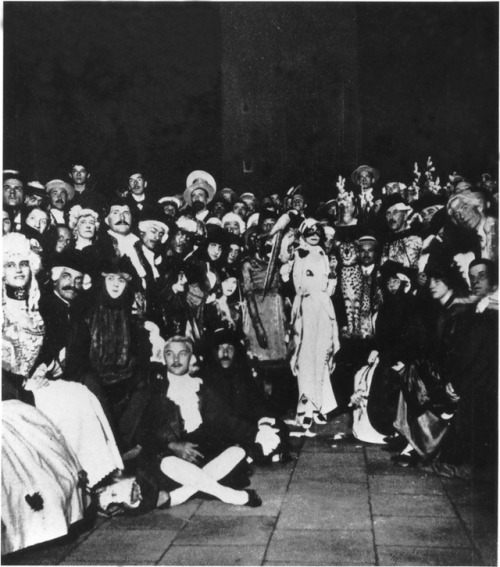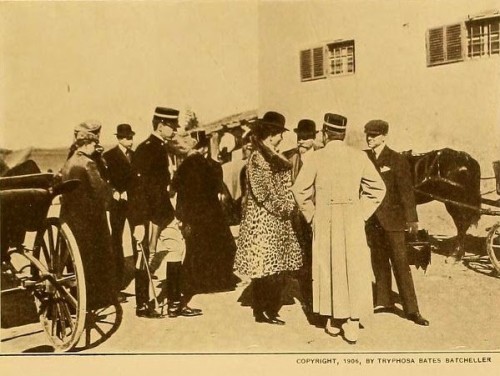#italian socialites
Marchesa Luisa Casati as Empress Theodora wear a crown formed of eagles, 1905.
On March 2, 1905, Tryphosa Bates Batchellerwrites:
It was supposed to be a ball characterized by the fancy dressing of the head and hair, but, as a matter of fact, most of the women came in elaborate and beautiful costumes. Far and away the most elegant and most beautiful costume was worn by the Marchesa Camillo Casati, of the famous Casati family of Milan. She was dressed as the Empress Theodora, in a perfect fitting princesse gown of cloth of silver heavily embroidered in gold. The costume was an exact reproduction of one worn in Paris by Sarah Bernhardt a short time ago. The Marchesa wore on her head a crown formed of eagles, and had some of her diamonds set up in a large diamond eagle, which was her only corsage ornament. Two or three ropes of her wonderful and famous pearls hung loosely about her beautiful neck, and altogether she was quite the most stunning persona at the ball. She is a handsome woman, tall and slight, with a beautiful figure and splendid carriage. Her hair is a light chestnut color, and she is always pale, though her paleness is of that attractive sort that does not indicate ill-health. She is said to be one of the best dressed women in Rome on all occasion.
Post link
Marchesa Luisa Casati (centre in white) and Leopard at one of her legendary masquerades at Piazza San Marco in Venice, 1913.
Christie’s.
Post link
One hundred years ago this month, the renown Welsh artist Augustus John met the Marchesa Luisa Casati at a party in Paris. He described the meeting in his autobiography: “A lady of unusual distinction had entered. Her bearing, personality, and peculiar elegance seemed to throw the rest of the company into the shade….She moved about the ballroom with supreme ease, while looking about her with an expression of slightly malicious amusement. Our eyes met. Before leaving I obtained an introduction; it was the Marchesa Casati.” They quickly became lovers, and then life-long friends. John painted the Marchesa twice that spring; below is the first of the portraits. (x)
Post link
Marchesa Luisa Casati in leopard-skin coat, Photo by American socialite, club woman and concert singer Tryphosa Bates Batcheller, 1906.
American socialite Tryphosa Bates Batcheller runs into Luisa Casati again on March 23, 1905, writing:
“We have just come in from the last hunt of the season, and a very pretty and brilliant sight it was, too. …You remember about my speaking of the Marchesa Luisa Casati with her lovely gowns and jewels, but I forgot to say then, that she is one of the finest horsewomen in Italy. I am sending you a little picture that shows her in her long leopard-skin coat, just as she rode out in her carriage to the meet before mounting.”
Post link
Marchesa Luisa Casati in a fountain dress made of wires and lights by couturier Paul Poiret, at the Beaumont Ball held by the Count Etienne de Beaumont in Paris, 1924.
The Beaumont Ball in Paris 1924 (an event with a guest list so selective that Gabrielle Coco Chanel was excluded for being too ‘trade’), was a homage to Pablo Picasso and theCubists. The dress made entirely from wires and lights, it was too wide for the entrance to Beaumont’s ballroom: the artist Christian Bérard, who witnessed Marchesa Luisa Casati attempting to squeeze through the doorway, reported that she collapsed like a “smashed zeppelin”. (x)
De Beaumont’s fêtes reached an apex in 1924 with the ballet series Soirées de Paris, which took place at the Théâtre de la Cigale in Montmartre from May 17 to June 30, 1924. An homage to the review of the same name by Guillaume Apollinaire, the series included the scandalous ballet Mercure, which featured music composed by Erik Satie, sets and costumes designed by Pablo Picasso, and choreography devised by Léonide Massine. (x)
Post link





